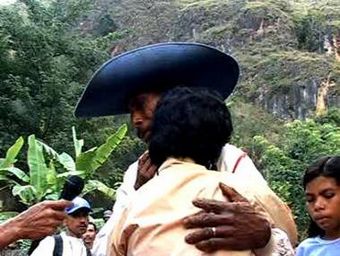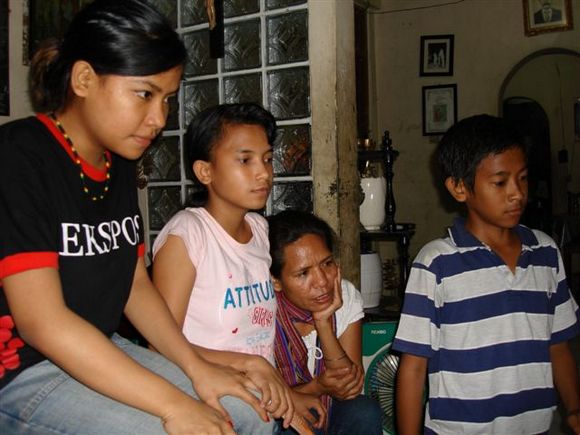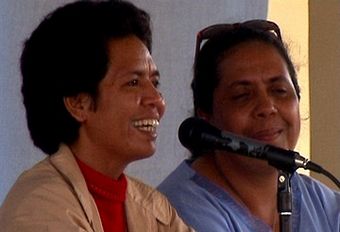A child abducted during the Indonesian occupation returns to her former home
Helene van Klinken
Biliki was born in a remote village in the mountains of central Portuguese Timor. When the Indonesians invaded the territory in late 1975, Biliki fled with her parents and other villagers to the forested mountains, under the protection of East Timorese fighters waging a war against the Indonesian military. Eventually Biliki and the people with her were captured and placed in a military holding camp in Ainaro. She was just seven years old.
In the camp an Indonesian Special Forces soldier saw Biliki and decided that he would take her to Indonesia. He attracted her attention with sweets and pretty clothes. He told her parents that he would educate her in Indonesia and gave them a small amount of money, rice and a horse. They were afraid of him and had no way to prevent him from removing their daughter. She still vividly recalls screaming and protesting as the soldier took her away by helicopter.
Biliki was given another name and grew up knowing nothing of her biological family and her East Timorese heritage
The soldier took Biliki to the Kopassus complex in Cigantung, Jakarta. However, she found it difficult to adjust to life in Indonesia. She says that a soldier who kidnapped a child should have anticipated that the child would feel angry and resentful. Like many of the children taken to Indonesia by soldiers, Biliki was given to another military family. In her third family she began to find acceptance and happiness and she now regards this family as her own. They had six sons and the eldest child was a daughter. They treated her well and sent her to school, giving her an education for which she is grateful. Later she married an Indonesian soldier and now has three children of her own.
Making Indonesians
Biliki was one of approximately 2000 young children taken from East Timor by Indonesian soldiers during the early years of the occupation. The soldiers wanted to help the East Timorese by giving the children a superior education in Indonesia. Throughout the Indonesian occupation, government departments and religious organisations also provided many opportunities for older students to study in Indonesia. These older East Timorese students were able to maintain their links with East Timor; indeed many of them became activists in the struggle for independence.
By contrast young dependent children had no choice other than to become Indonesians, adopting the culture, religion and language of their adoptive families. Biliki was given another name and grew up knowing nothing of her biological family and her East Timorese heritage.
Tracing their families
 |
Biliki is reunited with her father in the mountains of East Timor.CAVR, June 2004 |
After East Timor’s independence from Indonesia in 1999, Biliki asked the Commission for Reception, Truth and Reconciliation in East Timor (CAVR) to help her trace her family. In mid-2004 the CAVR broadcast her story on its radio program. Biliki told listeners that all her life she had been yearning to be reunited with her family in East Timor. The only information she could remember about herself was her East Timorese name, the names of her parents and an uncle, and that she had been abducted from Ainaro. Biliki’s cousin, Lorena, heard the plea on the radio program. She recognised her father’s name and remembered a story in their family about a missing girl. After discussing together the likelihood that this was their relative, the family contacted the CAVR.
Two months later, after 27 years in Indonesia, Biliki was on her way back to East Timor. She felt as if it was a dream, but she was also worried. What if no one came to meet her at the airport in Dili? What if it was dangerous in East Timor as she had so often heard in Indonesia? However, everything went smoothly and she was met by a CAVR Commissioner. The next day the CAVR took her to meet her mother and father, both of whom were still alive, in their remote village an hour’s walk from Dare, south of Dili. Any worries she had about whether or not they were her family were soon dispelled as she saw how much she resembled other members of the family. However, she could no longer speak the language of her parents, just the language of hugs and tears. It was a homecoming for Biliki after years of longing and hoping, but with it came the realisation that it would be difficult to return to East Timor; her future is with her young family in Indonesia.
Biliki was fortunate as she had assistance from the CAVR to help her to trace her family. Other East Timorese who were taken away as children by soldiers also want to find their families, even though most accept, just as Biliki had to, that they have become Indonesians and that they will probably not be able to return permanently to East Timor. However, many do not have enough information about their East Timorese origins, or the resources to initiate a search. There are others like Lucia, taken away by a soldier when she was seven years old, who have returned to East Timor and still search for their families. The soldier who took Lucia treated her well, but always refused to give her information about East Timor and where he had found her – information that could assist her in tracing her family.
New meanings from old relationships
 |
Biliki with her three children in Jakarta, August 2006 /Helene van Klinken |
The stories of children like Biliki and Lucia are a little known aspect of the relationship between Indonesia and East Timor. The experiences of these young children are examples of the oppression and deprivation suffered by all East Timorese. But they also present us with many instances of individual Indonesians showing genuine care and concern towards East Timorese children. The attachments formed between the colonial Indonesians who tried to help and the children they raised and educated in Indonesia will continue. Understanding these relationships gives us a more nuanced appreciation of the intertwined social dynamics that are present in the post-colonial relationships between the people of the new, young nation of East Timor and those of its powerful neighbour. ii
Helene van Klinken (helenevk@gmail.com) has recently completed a PhD at the University of Queensland. Her thesis considers the transfer of East Timorese children to Indonesia.












